Transcranial magnetic stimulation or TMS is an FDA approved treatment for major depressive disorder (MDD). It works by delivering electrical impulses through coils placed on the scalp. The device sends a pulse of energy into the brain via a coil placed over the left or right side of the head. This stimulates nerve cells in the area of the brain responsible for mood regulation.
TMS is also used for various mental health issues treatment. This technique is being studied for the treatment of obsessive-compulsive disorder, depression and various other mental health related conditions. TMS therapy is completely noninvasive, it is a much better option than other therapeutic approaches have not deemed good results. The side effects in case of TMS are generally temporary and mild.
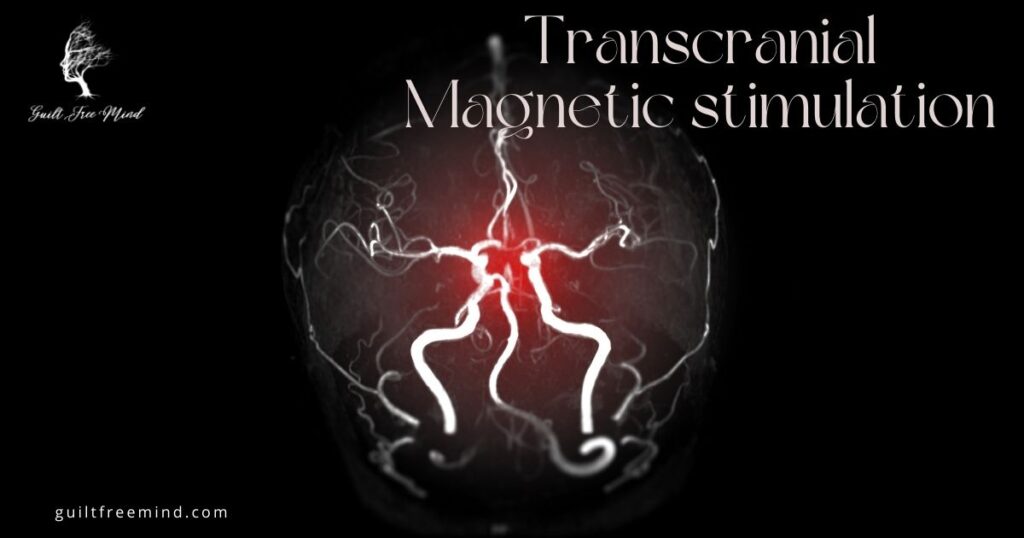
Table of Contents
What is transcranial magnetic stimulation (TMS)?
Transcranial magnetic stimulation is primarily a non-invasive treatment method that is used for the treatment of variety of mental health issues. In this treatment modality, a magnetic coil is used to influence the natural electric activity of the brain. In other words, this method targets the neurons of the brain. It was first developed in the year 1985. Now, TMS is not only being used to treat mental health conditions. It is also used to treat other physiological disorders like Parkinson’s etc.
How does transcranial magnetic stimulation work?
If you decide to go in for a repetitive TMS session, an electromagnetic coil will be placed against your scalp. The positioning of the electromagnetic coil will be close to your forehead. This electromagnet will deliver a magnetic pulse into your brain. Magnetic stimulation causes production of electricity. The brain contains neurons which work by using electrical impulse. Therefore, the stimulation converts the magnetic field into an electrical impulse and stimulates the nerve cells in different regions of the brain.
If TMS is used to treat major depressive disorder, the electromagnetic pulses will target the sections that are involved in depression and mood control. In case of rTMS, the frequency of magnetic stimulation that is used is focused on stimulating the neuronal activity in specific sections of the brain. Therefore, the TMS procedure can also be viewed as an MRI scan. The magnetic pulses are primarily responsible for waking up cells in sections of your brain that are responsible for controlling your mood (in case of depression treatment).
Effect of the electromagnetic pulse on the activity of the brain
As I mentioned before, transcranial magnetic stimulation relies on two basic physics principles. These are magnetism and electricity. Since these two principles cooperate with one another, TMS uses their ability to work together for the treatment. The magnetic impulse that is supplied is converted into electricity and used for the manipulation of the neurons.
This space that surrounds the magnet is activated. The influence the magnet has on the space surrounding it is referred to as a magnetic field. The magnetic field cannot be seen. However, the space surrounding the magnet still exerts its force. Let’s understand this in layman terms. You don’t have to make the magnet touch an object for the magnet to exert its magnetic force. If you bring a magnet close to a nail, the magnet will attract the nail towards it. You don’t have to necessarily make the magnet touch the nail for that effect to occur. Similarly, when a magnet is brought near your brain (brain has neurons which are constantly conducting electricity), the interaction that occurs between the magnetic field and the conducive item (brain) generates electricity.
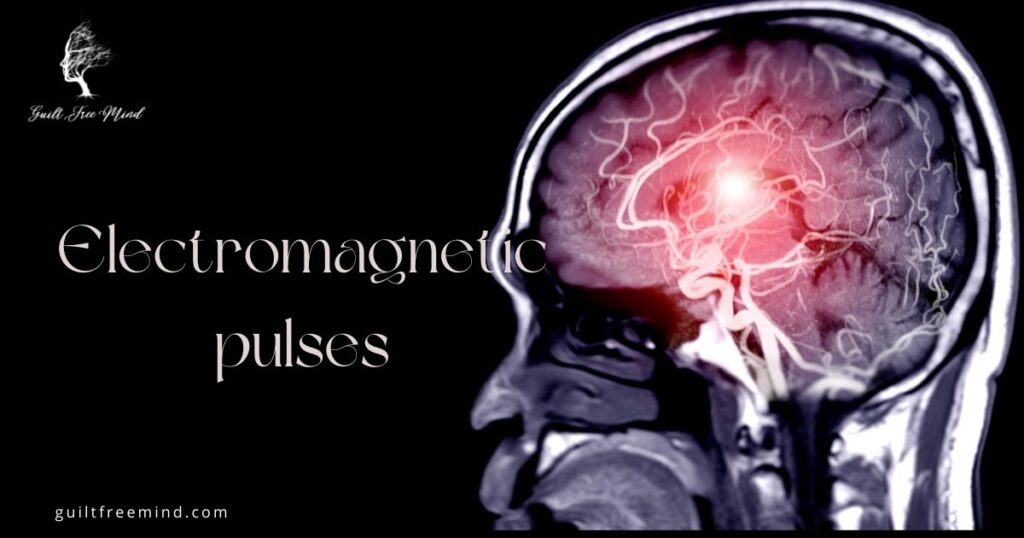
How does TMS manipulate the neurons?
As you know by now, brain is electrically active. The cells that are present in your brain and the nerves (neurons) use miniscule levels of energy to relay information throughout your body and brain. As I mentioned before, a magnet can influence the electrical activity when brought close to an object that’s conducting electricity. Similarly, when a magnet is brought close to the brain it can change the electrical activity in the brain. This is why, during TMS only specific sections of the brain are targeted. If other sections (that are conducting the right level of neurotransmitters) are subjected to the magnetic field it, it may result in a negative effect.
During the TMS procedure, the sections of the brain that control internal decision making, emotions, understanding pleasure etc. are targeted.
During TMS procedure, a magnetic pulse is sent into the brain. The brain is not subjected to a constant magnetic field. This is why the magnet used for the procedure is repeatedly switched on and off via electrical conduction. Furthermore, for such a procedure a magnet is required that is much stronger than any average magnet that you can find in the store or the ones that are available at your home.
Understanding the different forms of TMS
TML can be performed in many different ways. The primary difference between the various TMS types is the strength of the magnet and the different mannerism in which the magnetic pulse is sent to the brain.
Factors governing the different forms of TMS
Strength of the magnet
Tesla is the unit for measuring magnetic strength. Most of the magnets that are used for transcranial magnetic stimulation generate a magnetic field of 1.5 T – 2T. This strength is similar to the strength of the magnets that are used in the MRI scanner. However, in case of a TMS the section of the brain where the magnetic pulse is directed is much smaller. In case of MRI, the targeted section is much larger.
The frequency of the pulse
Every time the magnetic field is switched on and off, it causes a magnetic pulse. The frequency of TMS can be defined as the number of pulses sent into the brain in one second. The frequency is measured in Hertz (Hz). TMS is usually conducted at either low frequency pulses [1 Hz or one pulse per second] or high frequency pulses (5 to 10 Hz or 5-10 pulses every second). In case of rTMS, repetitive pulses are used.
The different pulse patterns
TMS can also differ based on the pulse patterns. Pulse pattern indicates what frequency of pulse is sent into the brain every second. For example the theta burst simulation (TBS). In case of Theta burst stimulation, high frequency pulses are used (5 hertz). A triplet of the high frequency pulses are sent into the brain in one second. Therefore, the brain receives 15 pulses in a second. The reason this pulse pattern is favored is because it has been observed to speed up the treatment. This form of pulse pattern has made the treatment of TMS six times faster than all the other methods.
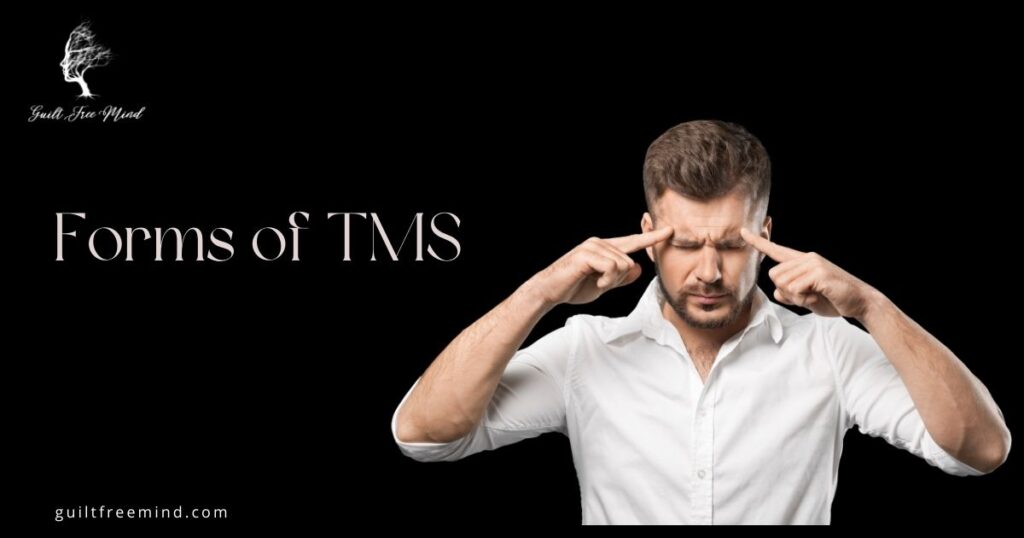
Simulation target and magnetic coil
In TMS, magnetic coils are used for targeting different brain sections. If the therapist has opted for deep TMS, It will involve the use of a H shape helmed coil. This helmed coil can reach the deeper structures of the brain than rTMS or DBS. Deep TMS is primarily used for treating conditions like obsessive compulsive disorder.
When does the therapist opt for a transcranial magnetic stimulation?
Therapists normally arrive at TMS once every other treatment option has either failed or been unsuccessful in delivering the desired results. The reason TMS is favored is because it is completely noninvasive. There is no surgery involved in this process and the complete treatment occurs through the skin. The patient does not even have to shave their head for this method. TMS is being used as an alternative to treatment methods like electroconvulsive therapy (ECT). If ECT cannot be performed on the patient or if it is an ineffective option, TMS can step in as an alternative.
Conditions that can be targeted via TMS
The different conditions that a TMS can be used for can differ from one country to another. In case of the US, the Food and Drug Administration has allowed TMS to be used for treatment of four different conditions. These conditions are
- Major depressive disorder including treatment resistant depression
- Migraines
- Obsessive compulsive disorder
- Smoking cessation
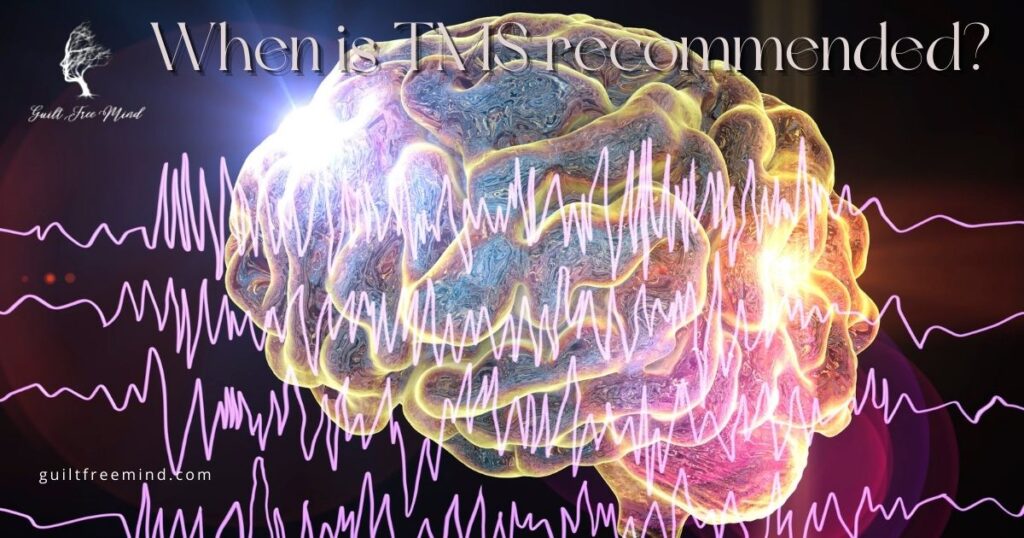
Along with the above-mentioned conditions that have been approved by the FDA, research is still going on to find out if other conditions can also be improved via the use of TMS. These studies are primarily targeting:
- Alzheimer’s disease
- Addictions
- Borderline personality disorder
- Bipolar disorder
- Eating disorders
- Chronic pain
- Fibromyalgia
- Essential tremor
- Parkinson’s disease
- Schizophrenia
- Post-traumatic stress disorder (PTSD)
- Complications from stroke
- Auditory hallucinations and tinnitus
- Traumatic brain injury
What is the frequency of TMS therapy?
So far, the data is not very clear about how many people are undergoing this form of therapy on an yearly basis. However, the frequency of treatment would depend on the severity of the condition. Therefore, your therapist may either pre-decide on a number of sessions before starting the treatment or they may observe the effectiveness and work as per that.
What do you need to know before you start the transcranial magnetic stimulation therapy?
Before you start undergoing TMS you need to have discussion with your specialist and health care provider. In most cases, the mental healthcare providers are responsible for referring the patient to a therapist who has a training and experience in transcranial magnetic stimulation. The therapist will also have a sit down session with you before the treatment starts. This is to make sure that you fit into the criteria of those who can undergo this therapy. They need to know if you are suffering from any condition that prevents you from being a viable candidate for this procedure.
Who should not undergo TMS?
For both MRI, and TMS, there are certain people who may not be fit for this procedure. The following conditions are when TMS is not an option for you.
You have an implant that contains a magnetic material or is electronic
Those who have pacemakers, screws in their bones, metal plates in the skull or bones etc. or any other metal item in their body cannot undergo TMS. The TMS magnet is very powerful. It can easily pull out any magnetic material that you have inside your body. This can cause severe pain and even internal injury.
You have a history of epilepsy, seizure or other brain condition
Even though this is fairly rare, TMS can cause seizures in the patient. If you have a condition that is related to seizure or epilepsy, or if you take medication that have seizures as a side effect, you are not eligible for TMS. The procedure may trigger convulsions. Therefore, under such circumstance, your mental health care provider may change your medication a week or so before starting TMS therapy. This is done so that the risks of undergoing conversions while inside the machine is eliminated.
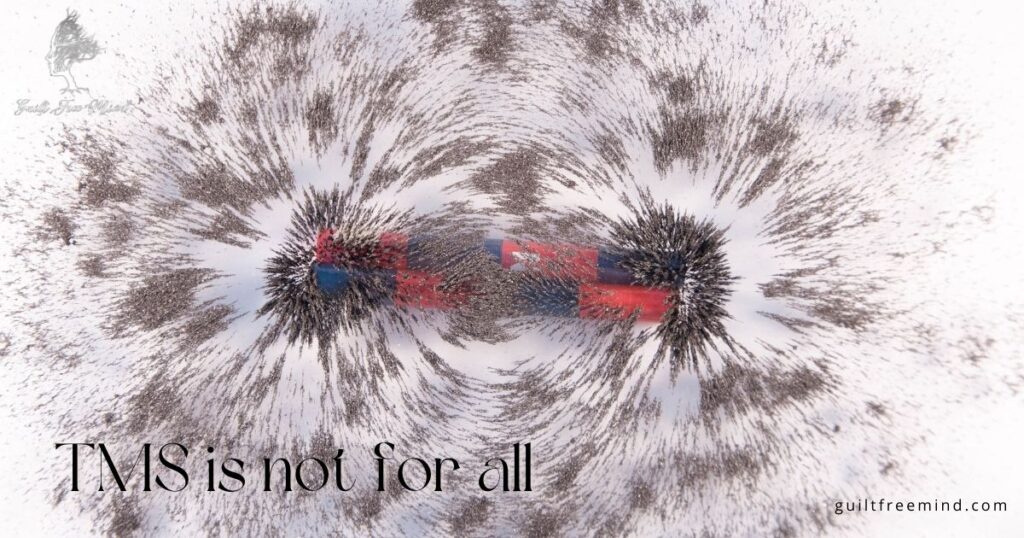
If your primary mental health care provider feels that EMS is a safe and good option for your treatment, they will have a discussion with you about the same. They will also tell you about the treatment schedule that they feel would be right for your recovery. Normally TMS takes multiple sessions. You may have to go for three to five sessions every week. These sessions are spread out over a period of several weeks.
TMS for depression
In case of the FDA approved protocols for treatment of depression, the TMS therapy will occur everyday for six weeks. Therefore, you will receive a treatment of 30 sessions. However, with the advent of new technology and newer treatment modalities, the treatment courses have been greatly reduced. In some cases, a single week is enough for full recovery.
Since there is variability in methods, options and treatment time, your mental health care provider is the best person to give you the details of the TMS therapy. They will also decide on the number of treatment sessions that you will need. Therefore, if you have further questions about TMS, the best person to ask would be your psychiatrist.
Getting ready for the transcranial magnetic stimulation procedure
Since TMS is a noninvasive procedure, you do not have to shave your hair or make any extra preparation before you start the treatment. The only thing that you have to be wary of is if you have any metal item or object on or inside your body. If you are wearing any rings, necklaces or hair clips, you must remove all of them before the procedure. In case you have metal implants in your body you are not fit for TMS itself.
Similar to MRI
If you have undergone MRI, you need not worry about TMS at all. The procedure of TMS is almost same as the procedure that is followed in MRI. Once you are ready to start the treatment, your provider will give you earplugs or any other hearing protection device. These devices are needed because the magnet makes a lot of noise during the treatment. The level of noise that the magnet generates is enough to disrupt your hearing. This is another similarity between MRI and TMS. If you have a sensitivity towards loud noises, please let your know provider know beforehand.

Magnet placement
Once you have settled in with your hearing protection, your provider will place the magnet on your head. For this, they can either use a helmet that has the magnet inside it. Alternatively, in some machines, there is an extension arm that contains the magnet. In this device, the outer case of the magnet will be against your face. The specific placement method depends on the condition to be treated.
Finding out the pulse
Before the treatment starts, your provider will first give single pulse stimulation on the scalp. This is done to figure out which is the right location and setting to be used for the treatment procedure.
Once the magnet is in position, the treatment is started. You may feel a tapping sensation as the magnetic pulse strength is increased. If the pulse strength is very high, there may be movement or twitch in your limbs especially your thumbs and hands. This is very normal. Your provider will also keep an eye on it because it helps them understand the strength the strength of the pulse that is being delivered.
Delivery
Once the right pulse strength has been zeroed upon, your provider will start to deliver the specific magnetic pulse at certain intervals. As the magnet is turned on and off you may hear clicking sounds. This is completely normal. You can also hear pauses between pulse series. These pauses are there because the electricity used to power up the magnet also causes heating in the magnet. Therefore, the pauses help the magnet cool down.
Depending on the specific TMS type that you are being administered along with the magnetic field impulses, the treatment sessions usually last for a few minutes to around half an hour. If you want to know further details of exactly how long it will take, your provider is the best person to ask.
Post first session treatment
Once the first TMS treatment is done, the next session will either be same as the first one or similar to it. The only adjustment that will be made will depend on the changes in your symptom. Alternatively, if there have been some side effects from the treatment, your psychiatrist may suggest some changes in the method to avoid or curb the side effects as much possible.
After TMS
Once you have finished with your TMS session you can go back to your schedule for the day. You may have a lingering side effect like unusual sensations in the face or head, twitching etc. if you are facing symptoms right after TMS, your provider may ask you to wait a while before you leave. In most cases, the symptoms after treatment sessions are extremely mild and are observed only for few minutes.
Advantages of TMS therapy
There are many advantages of TMS therapy that has made it a useful treatment modality
Noninvasive
You don’t even have to shave your head for this procedure, much less undergo an invasive surgery. Once the treatment is done for the day, you can resume your normal day to day activities. There is no involvement of anesthesia, injection or any kind of discomfort.
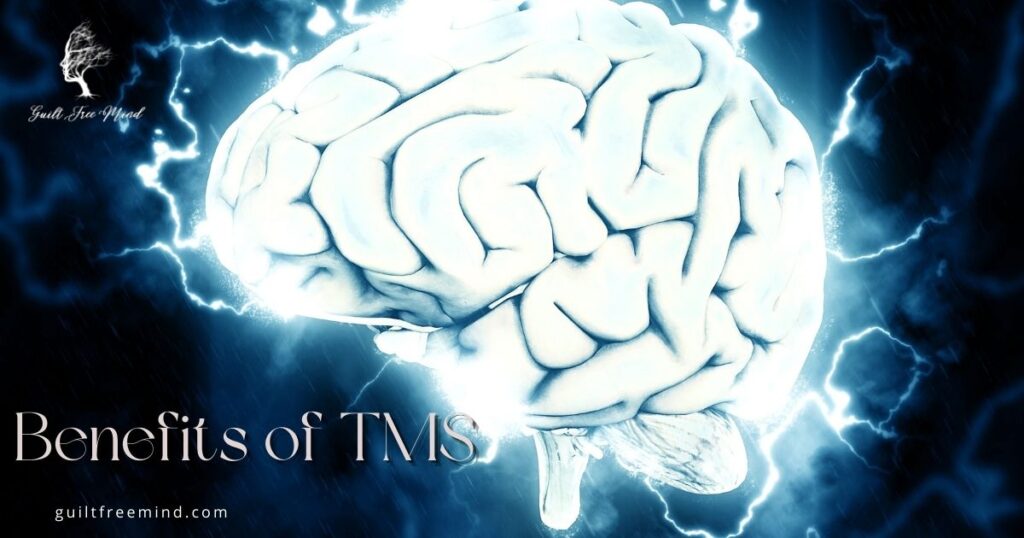
Safe
The most serious side effect that has been observed in case of TMS is seizure. However, these side effects are extremely rare. The risk of a person having seizures after TMS treatment is even rarer than 0.01%. Therefore, you do not have to worry about side effects. If you do face side effects, they will be gone within a few minutes after the treatment.
Extremely effective
The success rates of TMS generally vary depending on the condition. However, so far, the research shows that this method works.
Save lives
One of the conditions that TMS is used for is major depressive disorder (MDD). Major depressive disorder can be so severe that can cause the person to commit suicide. If TMS is started by the mental health care provider, it can save numerous lives by boosting the neurons that have started functioning in a dormant manner. This in turn leads to improvement in the symptoms and can lead to a complete depression remission.
Works with other treatment modalities
It does not matter what other treatments you are going undergoing, you can get TMS along with it. As long as your medications do not induce convulsions as side effects, TMS is safe for you. If your medications have a tendency of inducing convulsions, you may have to switch your medication before you start TMS.
Side effects, risks and complications
TMS causes very few risks, side effects and complications in the patients. As I mentioned before, the most likely side effect of TMS is seizure. However, the case where patients had a seizure after a TMS procedure is very rare. The risk of a person getting seizure after a TMS session is 1 in 10,000.
There are a few other complications. These are very mild and do not last for more than a period of a few minutes after the TMS session. These are
- Pain in the scalp or neck
- Headaches
- Lightedness or dizziness
- Temporary tinnitus (ringing in the ears)
- Tingling in the muscles of scalp or face
- High sensitivity to sound
Recovery time after TMS
Almost everyone undergoing a TMS treatment can immediately return to their normal activities. Some may need a few minutes to deal with the side effects. However, a few minutes is all they need to recover completely.

When should you seek medical attention after TMS treatment?
You should go to your mental health care provider as per your schedule. You do not have to change your daily schedule on account of TMS. Your mental health care provider will assess your condition and increase or decrease the number of TMS sessions depending on the progress. Therefore, you must not skip any of the sessions whether it is with your mental health care provider or for the TMS therapy. If you notice that the side effects after the TMS treatments are increasing or lingering for a long time, contact your mental health care provider.
Does TMS hurt the brain?
There have been many research studies conducted on TMS so far. None of these studies have shown that TMS causes no harmful effect on the brain. There have been very few cases where people have reported side effects that are of significant levels. However, the existence of such cases is extremely rare. Therefore, on a general note, it can be said that TMS is not harm the brain.
Conclusion
TMS or transcranial magnetic stimulation is a method that is used for boosting the regions of the brain that have gone dormant because of depression. Depression is not the only mental health condition that can be treated via TMS. Research is also going on to introduce TMS for treatment of other diseases as well like headaches, migraine, pain syndrome etc. if you want to know more about TMS and whether it is a solution for your depression, you should contact your mental health care provider.
If you have any queries related to this blog post or any other on Guilt Free Mind, feel free to reach out to me live on Twitch. I do co-working sessions daily from 11 AM to 7 PM Indian Standard Time. Co-working sessions boost productivity and, reduce procrastination. This makes you more focused and helps if you are feeling demotivated. I also host mental health sessions on Tuesdays and Fridays from 4:30 to 6:30 PM Indian standard time.
If you want to know more about mental health, the different psychological disorders and how to lead a more fulfilling life, please subscribe to the Guilt Free Mind. Your subscription will allow me to notify you the moment the next blog post is released. If you like watching videos, please subscribe to the YouTube channel of Guilt Free Mind. Do not forget to ring the notification bill
Have you ever undergone TMS treatment? If yes, how was your experience? Did you face any side effects? How many sessions per week did you attend? If you share your experiences with the world, it may provide someone else the courage to get the treatment that they deserve.
See you in my next blog post
Frequently Asked Questions
TMS is a safe, noninvasive treatment for depression that has been shown to be effective in treating MDD. It is also being studied as a potential treatment for other disorders such as anxiety, obsessive compulsive disorder, and posttraumatic stress disorder.
TMS works by sending magnetic pulses through the skull to stimulate certain parts of the brain. This stimulation helps to activate areas of the brain involved with mood regulation.
TMS has been shown to be effective in treating major depressive disorder (MDD) and other forms of depression. It is also being studied as an alternative treatment for bipolar disorder.
If you are suffering from severe depression, TMS may be a good option for you. However, there are some limitations to consider before deciding whether or not to undergo TMS therapy. Check the blog post to know the details.
You can learn more about TMS at the National Institutes of Health website.

4 Comments
Your article helped me a lot, thanks for the information. I also like your blog theme, can you tell me how you did it?
I am really loving the theme/design of your weblog. Do you ever run into any web browser compatibility issues? A few of my blog visitors have complained about my site not operating correctly in Explorer but looks great in Opera. Do you have any tips to help fix this problem?
Your article helped me a lot, is there any more related content? Thanks!
Your article made me suddenly realize that I am writing a thesis on gate.io. After reading your article, I have a different way of thinking, thank you. However, I still have some doubts, can you help me? Thanks.